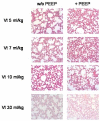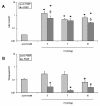Effect of low tidal volume ventilation on lung function and inflammation in mice
- PMID: 20409304
- PMCID: PMC2864238
- DOI: 10.1186/1471-2466-10-21
Effect of low tidal volume ventilation on lung function and inflammation in mice
Erratum in
- BMC Pulm Med. 2012;12:7
Abstract
Background: A large number of studies have investigated the effects of high tidal volume ventilation in mouse models. In contrast data on very short term effects of low tidal volume ventilation are sparse. Therefore we investigated the functional and structural effects of low tidal volume ventilation in mice.
Methods: 38 Male C57/Bl6 mice were ventilated with different tidal volumes (Vt 5, 7, and 10 ml/kg) without or with application of PEEP (2 cm H2O). Four spontaneously breathing animals served as controls. Oxygen saturation and pulse rate were monitored. Lung function was measured every 5 min for at least 30 min. Afterwards lungs were removed and histological sections were stained for measurement of infiltration with polymorphonuclear leukocytes (PMN). Moreover, mRNA expression of macrophage inflammatory protein (MIP)-2 and tumor necrosis factor (TNF)alpha in the lungs was quantified using real time PCR.
Results: Oxygen saturation did not change significantly over time of ventilation in all groups (P > 0.05). Pulse rate dropped in all groups without PEEP during mechanical ventilation. In contrast, in the groups with PEEP pulse rate increased over time. These effects were not statistically significant (P > 0.05). Tissue damping (G) and tissue elastance (H) were significantly increased in all groups after 30 min of ventilation (P < 0.05). Only the group with a Vt of 10 ml/kg and PEEP did not show a significant increase in H (P > 0.05). Mechanical ventilation significantly increased infiltration of the lungs with PMN (P < 0.05). Expression of MIP-2 was significantly induced by mechanical ventilation in all groups (P < 0.05). MIP-2 mRNA expression was lowest in the group with a Vt of 10 ml/kg + PEEP.
Conclusions: Our data show that very short term mechanical ventilation with lower tidal volumes than 10 ml/kg did not reduce inflammation additionally. Formation of atelectasis and inadequate oxygenation with very low tidal volumes may be important factors. Application of PEEP attenuated inflammation.
Figures





Similar articles
-
Increasing heterogeneity is associated with IL-6 expression in the lungs following mechanical ventilation.Am J Physiol Lung Cell Mol Physiol. 2025 May 1;328(5):L738-L747. doi: 10.1152/ajplung.00271.2024. Epub 2025 Apr 16. Am J Physiol Lung Cell Mol Physiol. 2025. PMID: 40241231
-
Low tidal volume and high positive end-expiratory pressure mechanical ventilation results in increased inflammation and ventilator-associated lung injury in normal lungs.Anesth Analg. 2010 Jun 1;110(6):1652-60. doi: 10.1213/ANE.0b013e3181cfc416. Epub 2010 Jan 26. Anesth Analg. 2010. PMID: 20103541
-
Mechanical ventilation with lower tidal volumes and positive end-expiratory pressure prevents pulmonary inflammation in patients without preexisting lung injury.Anesthesiology. 2008 Jan;108(1):46-54. doi: 10.1097/01.anes.0000296068.80921.10. Anesthesiology. 2008. PMID: 18156881 Clinical Trial.
-
High tidal volume upregulates intrapulmonary cytokines in an in vivo mouse model of ventilator-induced lung injury.J Appl Physiol (1985). 2003 Oct;95(4):1385-93. doi: 10.1152/japplphysiol.00213.2003. Epub 2003 Jun 13. J Appl Physiol (1985). 2003. PMID: 12807894
-
Lung recruitment maneuvers in acute respiratory distress syndrome and facilitating resolution.Crit Care Med. 2003 Apr;31(4 Suppl):S265-71. doi: 10.1097/01.CCM.0000057902.29449.29. Crit Care Med. 2003. PMID: 12682451 Review.
Cited by
-
Imaging technologies and basic considerations for welfare of laboratory rodents.Lab Anim (NY). 2015 Mar;44(3):97-105. doi: 10.1038/laban.665. Lab Anim (NY). 2015. PMID: 25693107 Review.
-
Suppressive oligonucleotides inhibit inflammation in a murine model of mechanical ventilator induced lung injury.J Thorac Dis. 2016 Sep;8(9):2434-2443. doi: 10.21037/jtd.2016.08.18. J Thorac Dis. 2016. PMID: 27746995 Free PMC article.
-
Performance Testing of a Homemade Aerosol Generator for Pulmonary Administration of Dry Powder Formulations to Mice.Pharmaceutics. 2023 Jun 28;15(7):1847. doi: 10.3390/pharmaceutics15071847. Pharmaceutics. 2023. PMID: 37514034 Free PMC article.
-
Augmented Ouabain-Induced Vascular Response Reduces Cardiac Efficiency in Mice with Migraine-Associated Mutation in the Na+, K+-ATPase α2-Isoform.Biomedicines. 2023 Jan 25;11(2):344. doi: 10.3390/biomedicines11020344. Biomedicines. 2023. PMID: 36830881 Free PMC article.
-
Long-Term Pulmonary Dysfunction by Hyperoxia Exposure during Severe Viral Lower Respiratory Tract Infection in Mice.Pathogens. 2022 Nov 12;11(11):1334. doi: 10.3390/pathogens11111334. Pathogens. 2022. PMID: 36422586 Free PMC article.
References
-
- Webb HH, Tierney DF. Experimental pulmonary edema due to intermittent positive pressure ventilation with high inflation pressures: protection by positive end-expiratory pressure. Am Rev Respir Dis. 1974;110:556–565. - PubMed
-
- Al-Jamal R, Ludwig MS. Changes in proteoglycans and lung tissue mechanics during excessive mechanical ventilation in rats. Am J Physiol Lung Cell Mol Physiol. 2001;281:L1078–L1087. - PubMed
MeSH terms
Substances
LinkOut - more resources
Full Text Sources

